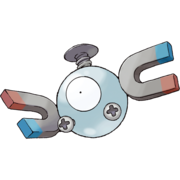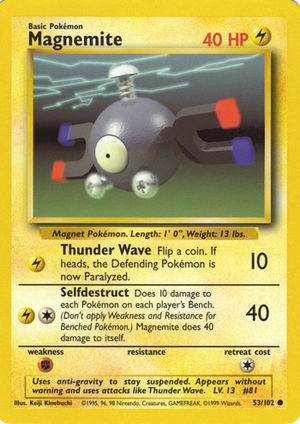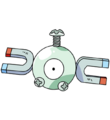|
|
|
|
|
|
|
|
|
|
|
|
|
|
Height
1' 00"
Imperial
|
0.3m
Metric
|
1' 00"/0.3m
|
0.0m
|
|
|
Weight
13.2lbs
Imperial
|
6.0kg
Metric
|
13.2lbs/6.0kg
|
0.0kg
|
|
|
|
|
|
|
|
|
|
|
|
|
EV yield
HP
0
|
Atk
0
|
Def
0
|
Sp.Atk
1
|
Sp.Def
0
|
Speed
0
|
| Base Exp.: 89
|
Battle Exp.: 635*
|
|
|
Magnemite (Japanese: コイル Coil) is a dual-type Electric/Steel Pokémon, and formerly, in Generation I, a pure Electric-type Pokémon.
It evolves into Magneton starting at level 30, which evolves into Magnezone when leveled up in Mt. Coronet or Chargestone Cave.
Overview
Magnemite is a pseudo-robotic life form consisting of a round metal body, two horseshoe magnets, and some phillips head screws. It floats through the air using magnetism which it also consumes for energy. Magnemite are generally found around power plants or mountainous regions with substantial metal content. They are generally docile and keep to themselves and only attack when provoked, but they may react differently if a large magnetized object is nearby.
Gender differences
Magnemite is a genderless species.
Male is blue and female is pink. Males have a facial covering resembling a moustache, while females have one resembling a fluffy collar. Males have diamonds on their inner tentacles and females have frills. Males lack a mouth, while females have one shaped like a heart. Females have two eyelashes and larger eyes while males have small eyes and one small upper eyelash. Males have more frills on their outer tentacles.
| Male
|
Female
|

|

|
In the games
Stats
Base stats
Pokéathlon stats
Type effectiveness
| Under normal battle conditions in Generation V, this Pokémon is:
|
|
|
|
|
|
|
|
|
|
|
|
|
Learnset
|
|
|
|
- Bold indicates a move that gets STAB when used by Magnemite
- Italic indicates a move that gets STAB only when used by an Evolution of Magnemite
- Click on the generation numbers at the top to see level-up moves from other generations
|
|
|
| Father |
Move |
Type |
Cat. |
Pwr. |
Acc. |
PP
|
| This Pokémon learns no moves by breeding.
|
- Moves marked with an asterisk (*) must be chain bred onto Magnemite in Generation V
- Moves marked with a double dagger (‡) can only be bred from a Pokémon who learned the move in an earlier generation.
- Moves marked with a superscript game abbreviation can only be bred onto Magnemite in that game.
- Bold indicates a move that gets STAB when used by Magnemite
- Italic indicates a move that gets STAB only when used by an Evolution of Magnemite
- Click on the generation numbers at the top to see Egg moves from other generations
|
In events
Game locations
| This Pokémon was unavailable prior to Generation I.
|
|
|
|
|
|
|
|
|
|
|
|
|
Held items
Pokédex entries
| This Pokémon was unavailable prior to Generation I.
|
| Generation I
|
|
| Red
|
Uses antigravity to stay suspended. Appears without warning and uses Thunder Wave and similar moves.
|
| Blue
|
| Yellow
|
It is born with the ability to defy gravity. It floats in air on powerful electromagnetic waves.
|
| Stadium
|
Appears as if out of nowhere. It floats using anti-gravity and discharges electricity from two side-mounted units.
|
|
|
| Generation II
|
|
| Gold
|
It is attracted by electromagnetic waves. It may approach trainers if they are using their Pokégear.
|
| Silver
|
The units at the sides of its body generate anti-gravity energy to keep it aloft in the air.
|
| Crystal
|
The electricity emitted by the units on each side of its body cause it to become a strong magnet.
|
| Stadium 2
|
It is attracted by electromagnetic waves. It may approach trainers if they are using their Pokégear.
|
|
|
| Generation III
|
|
| Ruby
|
Magnemite attaches itself to power lines to feed on electricity. If your house has a power outage, check your circuit breakers. You may find a large number of this Pokémon clinging to the breaker box.
|
| Sapphire
|
Magnemite floats in the air by emitting electromagnetic waves from the units at its sides. These waves block gravity. This Pokémon becomes incapable of flight if its internal electrical supply is depleted.
|
| Emerald
|
The units at its sides are extremely powerful magnets. They generate enough magnetism to draw in iron objects from over 300 feet away.
|
| FireRed
|
It moves while constantly hovering. It discharges Thunder Wave and so on from the units at its sides.
|
| LeafGreen
|
Uses antigravity to stay suspended. Appears without warning and uses Thunder Wave and similar moves.
|
|
|
| Generation IV
|
|
| Diamond
|
The units at its sides generate electromagnetic waves that keep it airborne. It feeds on electricity.
|
| Pearl
|
{{{pearldex}}}
|
| Platinum
|
The faster the units at its sides rotate, the greater the magnetic force they generate.
|
| HeartGold
|
It is attracted by electromagnetic waves. It may approach trainers if they are using their Pokégear.
|
| SoulSilver
|
The units at the sides of its body generate antigravity energy to keep it aloft in the air.
|
|
|
| Generation V
|
|
| Black
|
The faster the units at its sides rotate, the greater the magnetic force they generate.
|
| White
|
{{{whitedex}}}
|
| Black 2
|
The electromagnetic waves emitted by the units at the sides of its head expel antigravity, which allows it to float.
|
| White 2
|
{{{white2dex}}}
|
|
|
|
|
Sprites
Evolution
Side game data
Side game locations
NPC appearances
In the anime
Major appearances
Magnemite first appeared in Sparks Fly for Magnemite. Ash and his friends were in Gringey City while the power went out. When they were looking around for the cause of the power outage, a lone Magnemite showed up and was feeling attracted to Ash's Pikachu, who had a cold. When a group of Grimer and its Muk leader were chasing Ash and his friends, a group of Magnemite and Magneton helped to fight them off.
In Get Along, Little Pokémon, Ash, Misty and Tracey met a man named Ethan who used Magnemite to harness electrical energy from bolts of lightning during thunderstorms and then the electrical energy would be given to towns that were without power. Magnemite #6 evolved into a Magneton to save Ash and Pikachu from Team Rocket.
A group of Magnemite and a Magneton appeared as security guards in Current Events as they first attacked Team Rocket who sneaked into a power station guarded entirely by Pokémon. Ash saw the door had been opened by someone, and upon investigatation, was also attacked by the Magnemite.
A Magnemite belonging to the Olivine City Gym Leader, Jasmine, makes its debut in Fight for the Light! riding on Jasmine's shoulder through the whole episode. It is later used in her Gym Battle with Ash in Nerves of Steelix!, sending it out against Ash's Pikachu.
An army of Magnemite and Magneton, led by a Magnezone, appeared in Giratina and the Sky Warrior under the ownership of the main villain, Zero. They were used by Zero as a swarm to trap or capture, as well as being able to contain people and Pokémon by linking together around them, preventing them from moving.
Minor appearances
Two Magnemite appeared in Lights, Camera, Quack-tion, acting as lighting technicians for the film "Pokémon in Love".
Four Magnemite were among the Pokémon controlled by Cassidy and Butch in Pikachu Re-Volts.
Multiple Magnemite also appeared in The Power of One.
Three Magnemite belonging to a group of Phony Pokémon interpreters appeared in The Poké Spokesman where they were convinced by Simon to cease their attacks.
Ash has battled another Gym Leader with Magnemite: Wattson in Watt's with Wattson?.
Several Magnemite were among the Electric Pokémon that were lured by the "Miracle Crystal" that Attila and Hun were using in The Legend of Thunder!.
Magnemite is one of the Electric-type Pokémon that was seen in the lake with crystal in As Clear As Crystal.
A Magnemite was partnered with two Team Rocket trainees in Training Daze.
Some Magnemite, their evolved form Magneton, a Steelix, and a Skarmory appeared in All Torkoal, No Play!.
A Magnemite appeared in the opening of Lucario and the Mystery of Mew.
Brock temporarily trained a Magnemite belonging to the Pokémon Summer Academy in Camping It Up!. Unlike the rest of the group, Brock had no problems bonding with and educating his Pokémon.
A group of Magnemite also appeared in Steeling Peace of Mind! and Saving the World From Ruins! along with numerous other Steel-type Pokémon (including some Magneton) on Iron Island.
A group of Magnemite served as guards for the Valley Windworks in Gone With the Windworks!.
A Magnemite belonging to Professor Kodama appeared in Sticking With Who You Know!.
Another Magnemite appeared in Dawn of a Royal Day!.
A Magnemite appeared in Expedition to Onix Island!.
A Magnemite appeared in Iris and the Rogue Dragonite!.
A Magnemite belonging to a Team Plasma Grunt appeared in BW112.
Pokédex entries
| Episode
|
Pokémon
|
Source
|
Entry
|
| EP030
|
Magnemite
|
Ash's Pokédex
|
Magnemite, a Magnet Pokémon. Its means of floating through the air are not understood. This very mysterious Pokémon is of the Electric type.
|
| Original series entries continue below.
|
|
| Episode
|
Pokémon
|
Source
|
Entry
|
| EP101
|
Magnemite
|
Ash's Pokédex
|
Magnemite, the Magnet Pokémon. It's able to float through the air and leave its Thunder Wave through its magnet shaped units located on its sides.
|
|
In the manga
In the Pokémon Adventures manga
Magnemite makes multiple cameos aboard the S.S. Anne in Danger: High Voltorb as many of the Pokémon ready to attack Red; however, it's not clear if they belong to Lt. Surge or to his Sailor. It debuts in the next round, Buzz Off, Electabuzz! searching in the ship for Red.
Later, in Volume 13, Lt. Surge uses a Magnemite to fight Morty's Misdreavus, using electromagnetism to shield attacks as well as fire Zap Cannon. The fight, however, ended in a draw due to Misdreavus using Destiny Bond.
Wattson's two Magnemite were first seen with his Electrike battling Pokémon belonging to certain children.
In the Pokémon Pocket Monsters manga
Green caught a Magnemite before participating in the sports meet in Pokémon Sports Meet!!.
Giovanni sent out Magnemite when he was about to destroy Pallet Town with a missile in PM047.
In the Pokémon Gold & Silver: The Golden Boys manga
Black owns a Magnemite in The Golden Boys manga.
In the TCG
- Main article: Magnemite (TCG)
Magnemite first appeared in the Pokémon Trading Card Game as apart of the Base Set. It has since appeared in 33 sets with 26 variations. It is usually a common card and normally of the Lightning-type or Metal-types. It is always a basic Pokémon.
Gallery
Art by Ken Sugimori from Red and Green
Art by Ken Sugimori from FireRed and LeafGreen
Art from the Original Series anime
Art from the Advanced Generation anime
Trivia
- In the Pokémon Red and Blue beta, Magnemite was originally known as "Coil", from its Japanese name.
- Magnemite is the first Steel-type Pokémon in National Pokédex order.
- Despite most of Magnemite's Pokédex entries saying they are able to float through the air by employing powerful electromagnetic waves or even anti-gravity, Magnemite does not have the Ability Levitate, and so they are still affected by Earthquake or other Ground-type moves. However, as of Generation IV, Magnemite can learn Magnet Rise, which simulates Levitate for five turns.
- Magnemite and its evolutionary line have twelve resistances and one immunity, making them the most resistant Pokémon to date. With the addition of Magnet Rise, which makes them immune to Ground-type attacks for five turns, their only double weakness is negated.
- Due to their inclusion in Platinum's extended Sinnoh Pokédex and the Unova Pokédex in Black 2 and White 2, Magnemite and Magneton have appeared in every regional Pokédex.
- Magnemite and its evolution Magneton are two of the few Pokémon that had their cry changed slightly in Generation III. This was due to Generation III utilizing a better sound effects game engine and newer game system.
- Magnemite and its evolutions are the only dual-type Electric Pokémon that are part of a three-stage evolutionary line.
- Magnemite is the first genderless Pokémon in the National Pokédex order.
- Pokémon Snap is the only form of a Pokémon canon that shows two Magnemite bonding, similar to a Magneton. However, when a picture is taken, they are still called Magnemite.
- Magnemite is currently the most traded Pokémon on the GTS. This is probably due to what is known as the Magnemite chain/coil: a scheme by which players can increase the number of visitors to their Join Avenue in Black 2 and White 2 by trading Magnemite on the GTS. The scheme originated with Japanese players and has spread around the globe.
Generation II type change
Magnemite, along with its evolution Magneton, were pure Electric-type in Generation I, but became dual-type Electric/Steel in Generation II. This makes them the first Pokémon to gain an extra type, the others being Rotom's other forms in Gen V. One could argue that this was purely because the Steel type had not been officially recognized by Pokémon researchers in Generation I; however, in FireRed and LeafGreen, they are Electric/Steel-type. The general consensus among fans is that the type change is simply a retcon, owing to the Magnemite evolution family clearly being metallic in origin, and the Steel type not existing until after they had debuted. Due to this type change, Magnemite is the first Steel-type Pokémon in National Pokédex order. However, it was unable to learn any Steel-type moves until Generation III.
Origin
Magnemite seems to be based on a magnet. It may also be based on the objectification of electromagnetism, one of the four fundamental interactions of nature.
Name origin
Magnemite may be a play on magnetite.
Coil is literally coil, perhaps referring to the fact that a coil with electric current generates a magnetic field.
In other languages
| Language
|
Title
|
Meaning
|
 Japanese Japanese
|
コイル Coil
|
From the English coil
|
 French French
|
Magneti
|
From magnétique, and petit
|
 Spanish Spanish
|
Magnemite
|
Same as English name
|
 German German
|
Magnetilo
|
From Magnet and ilo
|
 Italian Italian
|
Magnemite
|
Same as English name
|
 Korean Korean
|
코일 Koil
|
Transliteration of Japanese name
|
 Mandarin Chinese Mandarin Chinese
|
小磁怪 Xiǎocíguài
|
Literally "Little magnetic monster"
|
 Cantonese Chinese Cantonese Chinese
|
小磁怪 Síuchìhgwaai
|
Literally "Little magnetic monster"
|
|
|
|
| More languages
|
 Thai Thai
|
คอยล์ Coil
|
Same as Japanese name
|
|
|
|
External links
Notes

|
This Pokémon article is part of Project Pokédex, a Bulbapedia project that aims to write comprehensive articles on each Pokémon species, as well as Pokémon groups and forms.
|


















































